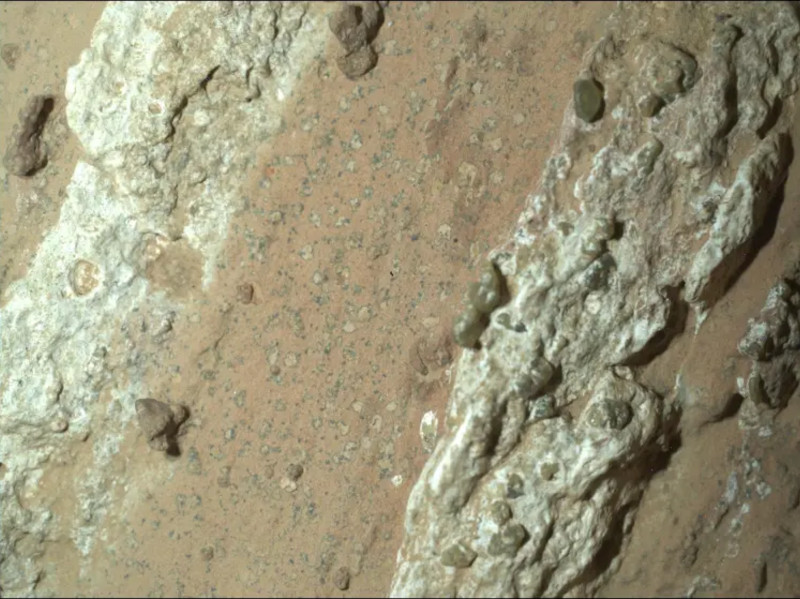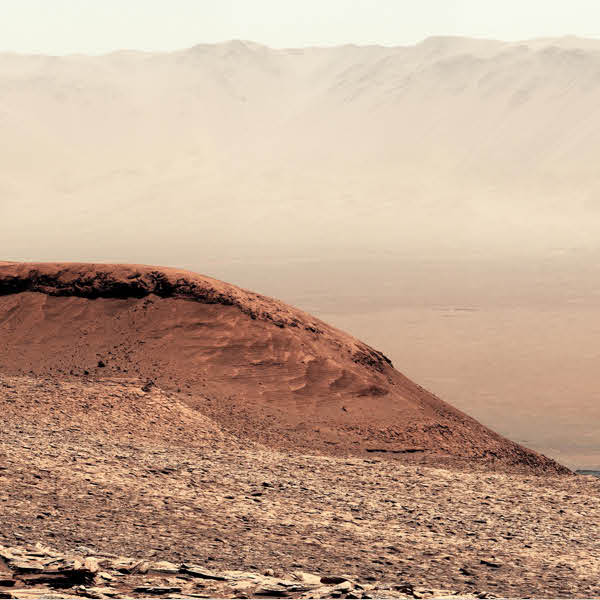
NASA's Perseverance Mars rover took this selfie, made up of 62 individual images, on July 23, 2024. A rock nicknamed “Cheyava Falls,” which has features that may bear on the question of whether the Red Planet was long ago home to microscopic life, is to the left of the rover near the center of the image.
Photo: NASA/JPL-Caltech/MSSS
Since its arrival on Mars in February 2021, NASA’s Perseverance Mars rover has explored the red planet to look for clues of past life and whether it was ever habitable. Now, it seems to have found its most significant lead. According to a paper published in Nature, a sample collected by Perseverance could hold evidence of ancient microbial life.
The key piece was found on an ancient dry riverbed in Jezero Crater. Thought to have once been flooded with water, it was named as the landing site for NASA's Mars 2020 mission. The sample was taken from a rock known as Cheyava Falls, named after a Grand Canyon waterfall, in 2024. Since its discovery, this rock has sparked interest among astrobiologists as a possible indicator that microbes thrived in the martian mud about 3.5 billion years ago.
The sample, known as Sapphire Canyon, seems to contain potential biosignatures—that is, a substance or structure that might have a biological origin. Particularly, researchers came across green leopard-like spots on reddish mudstone that signal a “redox reaction,” meaning that the organisms lost electrons to the mud and left behind minerals, such as vivianite and greigite.
However, this requires further study to determine whether it truly is a trace of life. “This is the first time that chemical processes consistent with—though not definitive proof of—a biological origin have been observed” on Mars, says Christian Schröder, a physicist at the Max Planck Institute for Solar System Research, told National Geographic.
The rock with the biosignatures belongs to a rugged area of Mars known as Bright Angel. It is located on the edges of Neretva Vallis, an ancient valley that began as a river running through it millions of years ago. There, the rover picked up on the unique composition of the outcrops. These sedimentary mudstone rocks are made up of clay and silt, known for doing a great job at preserving ancient microbial life on Earth. Additionally, they also hold other key minerals, such as organic carbon, sulfur, oxidized iron (rust), and phosphorus.
“The combination of chemical compounds we found in the Bright Angel formation could have been a rich source of energy for microbial metabolisms,” says lead study author and Perseverance scientist Joel Hurowitz. “But just because we saw all these compelling chemical signatures in the data didn’t mean we had a potential biosignature. We needed to analyze what that data could mean.”
If confirmed, this finding would mean that both Earth and Mars were home to microbes at the same time, and they all grew and thrived—offering revolutionary insights on how life finds its way to survival despite the conditions of its environment. “I think that could be telling us something really profound about how life evolves,” said geologist Michael Tice, who co-authored the study.
While this is the most convincing sign of possible life on Mars, other rovers have also found important clues. In 2018, the Curiosity rover found organic compounds in 3-billion-year-old mudstones. Before that, the Spirit Rover spotted an ancient hot spring environment at Gusev Crater, which on Earth is known to foster life.
Currently, academics can only go by the data offered by Perseverance, as a prospective future mission to bring samples to Earth is still in the design stage. “Ultimately, we conclude that analysis of the core sample collected from this unit using high-sensitivity instrumentation on Earth will enable the measurements required to determine the origin of the minerals, organics and textures it contains,” write the study authors.
Even if the confirmation takes decades of thorough investigation, it means we're one step closer to better understanding our celestial neighbor—and breaking the code on its ancient history.
According to a paper published in Nature, a sample collected by the Perseverance rover could hold evidence of ancient microbial life.

NASA's Perseverance rover discovered leopard spots on a reddish rock nicknamed “Cheyava Fallst in Mars' Jezero Crater in July 2024. Scientists think the spots may indicate that, billions of years ago, the chemical reactions in this rock could have supported microbial life; other explanations are being considered.
Photo: NASA/JPL-Caltech/MSSS
Sources: NASA Says Mars Rover Discovered Potential Biosignature Last Year; This is the best evidence yet for ancient life on Mars
Related Articles:
Scientists Discover Possible Ocean of Water Beneath Mars’ Surface
NASA’s Curiosity Rover Discovers Crystals of Pure Sulfur on Mars
Giant “Scar” on Mars Longer Than the Grand Canyon Spotted in New Satellite Image






















































































